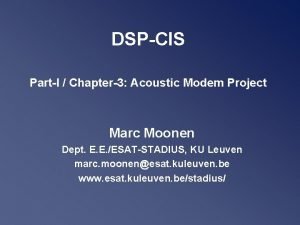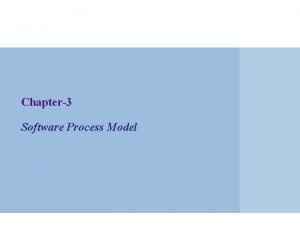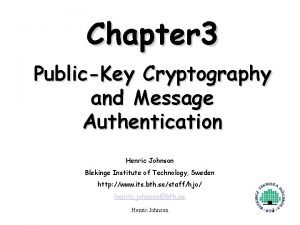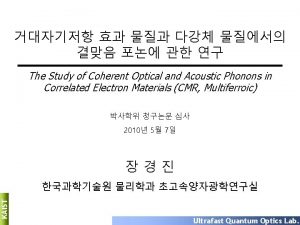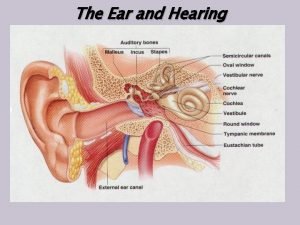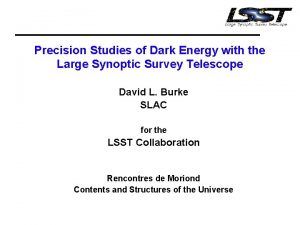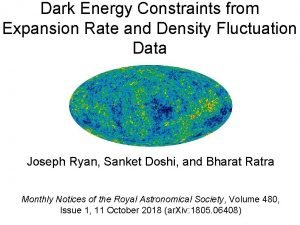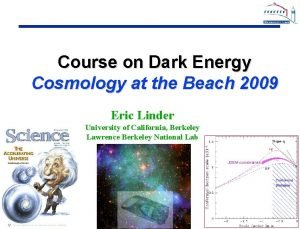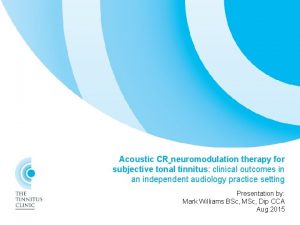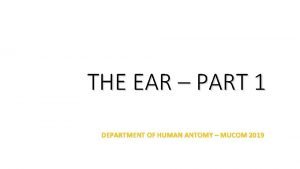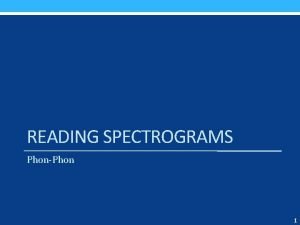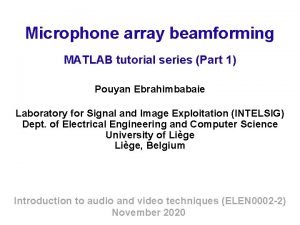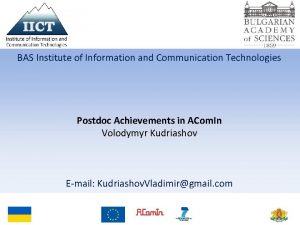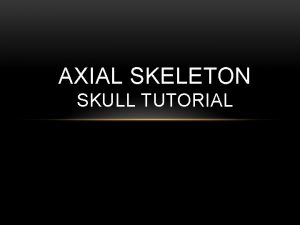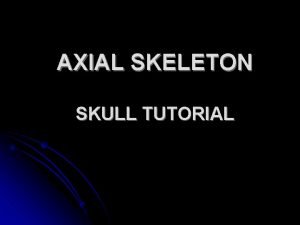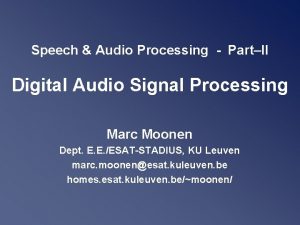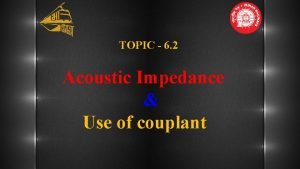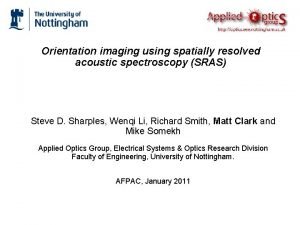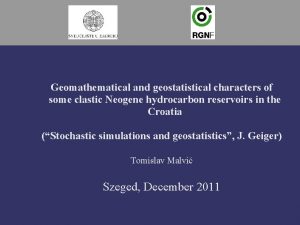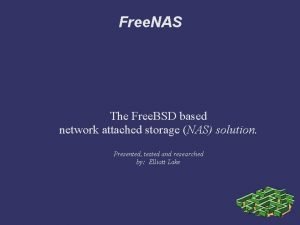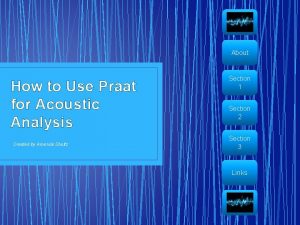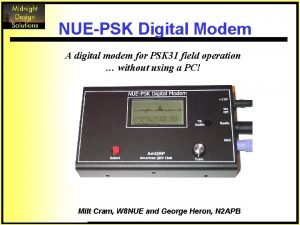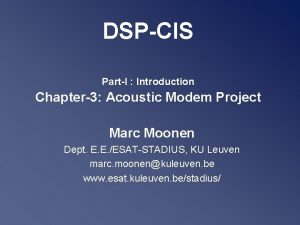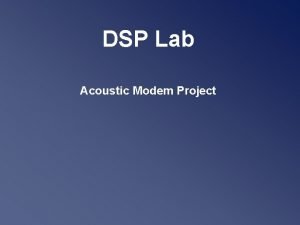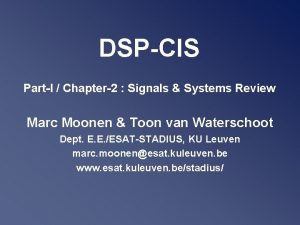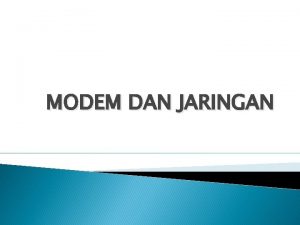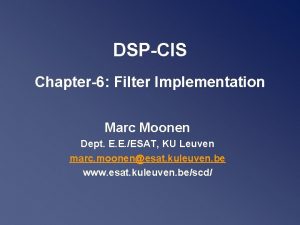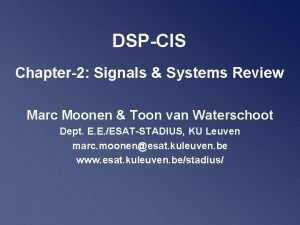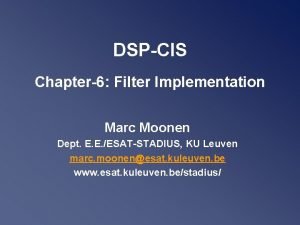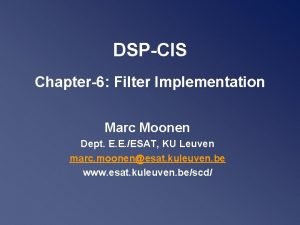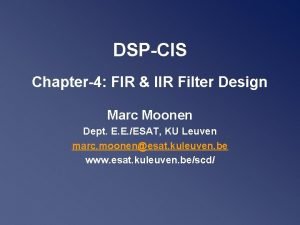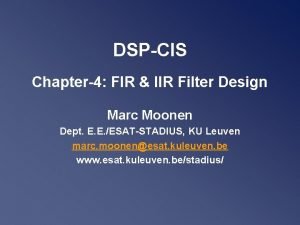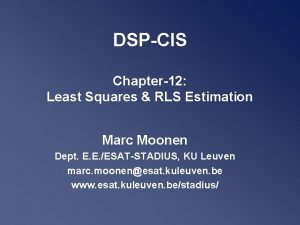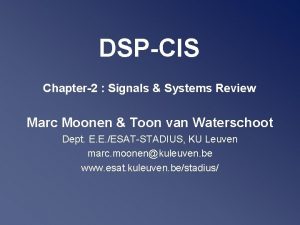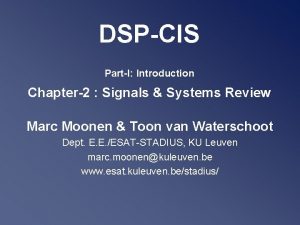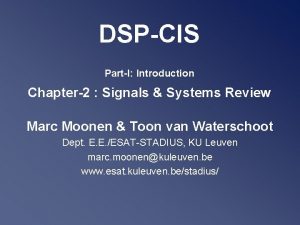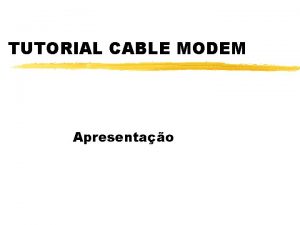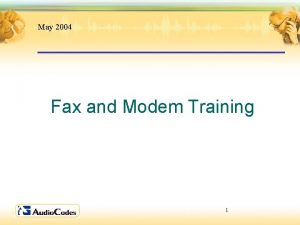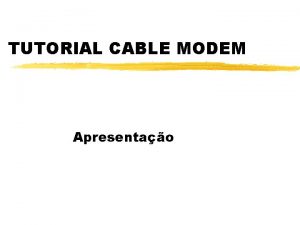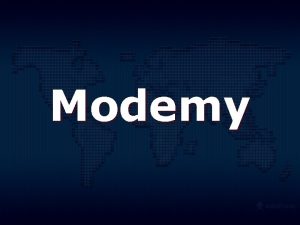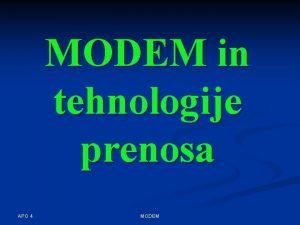DSPCIS PartI Chapter3 Acoustic Modem Project Marc Moonen








































- Slides: 40

DSP-CIS Part-I / Chapter-3: Acoustic Modem Project Marc Moonen Dept. E. E. /ESAT-STADIUS, KU Leuven marc. moonen@esat. kuleuven. be www. esat. kuleuven. be/stadius/

Chapter-3: Acoustic Modem Project • Introduction Overview & Target • Work Plan Week-1 Week-2: Channel modeling & evaluation Week 3 -4: OFDM modulation Week 5 -6 Week 7 -8 DSP-CIS 2015 / Part-I / Chapter-3: Acoustic Modem Project 2 / 40

Introduction/Overview Digital Picture (IN) Receiver Tx Transmitter Rx D-to-A A-to-D +filtering +amplif. +filtering +… – Digital communication over an acoustic channel (from loudspeaker to microphone) – FFT/IFFT-based modulation format : OFDM (as in ADSL/VDSL, Wi. Fi, DAB, DVB…) – Channel estimation, equalization, etc… DSP-CIS 2015 / Part-I / Chapter-3: Acoustic Modem Project Digital Picture (OUT) 3 / 40

Introduction • Digital communications over an acoustic channel: Discrete-time transmit signal (sampling rate Fs, e. g. 10 k. Hz) Tx D-to-A +filtering +amplif. Discrete-time receiver signal (sampling rate Fs, e. g. 10 k. Hz) A-to-D Rx +filtering +… DSP-CIS 2015 / Part-I / Chapter-3: Acoustic Modem Project 4 / 40

Introduction • Digital communications over an acoustic channel: Discrete-time transmit signal (sampling rate Fs, e. g. 10 k. Hz) Tx D-to-A +filtering +amplif. Discrete-time receiver signal (sampling rate Fs, e. g. 10 k. Hz) A-to-D Rx +filtering +… This will be the easy part… DSP-CIS 2015 / Part-I / Chapter-3: Acoustic Modem Project 5 / 40

Introduction • Digital communications over an acoustic channel: …straightforwardly realized (in Matlab/Simulink with `Real-Time Workshop’, see below) Discrete-time receiver signal Discrete-time transmit signal (sampling rate Fs, e. g. 10 k. Hz) Tx D-to-A +filtering +amplif. (sampling rate Fs, e. g. 10 k. Hz) A-to-D Rx +filtering +… Means we do not have to deal with hardware issues, components, etc. DSP-CIS 2015 / Part-I / Chapter-3: Acoustic Modem Project 6 / 40

Introduction • Digital communications over an acoustic channel: …and will be modeled by a linear Discrete-time discrete-time transfer function Discrete-time transmit signal (see below) (sampling rate Fs, e. g. 10 k. Hz) Tx D-to-A +filtering +amplif. receiver signal H(z) A-to-D Rx +filtering +… DSP-CIS 2015 / Part-I / Chapter-3: Acoustic Modem Project 7 / 40

Introduction • Digital communications over an acoustic channel: Discrete-time receiver signal Discrete-time transmit signal (sampling rate Fs, e. g. 10 k. Hz) Tx D-to-A +filtering +amplif. A-to-D Rx +filtering +… This is the interesting part… (where we will spend most of the time) DSP-CIS 2015 / Part-I / Chapter-3: Acoustic Modem Project 8 / 40

Introduction • Will use OFDM as a modulation format Orthogonal frequency-division multiplexing From Wikipedia, the free encyclopedia Orthogonal frequency-division multiplexing (OFDM), essentially identical to (…) discrete multi-tone modulation (DMT), is a frequency-division multiplexing (FDM) scheme used as a digital multi-carrier modulation method. A large number of closelyspaced orthogonal sub-carriers are used to carry data. The data is divided into several parallel data streams or channels, one for each sub-carrier. Each sub-carrier is modulated with a conventional modulation scheme (such as quadrature amplitude modulation or phase-shift keying) at a low symbol rate, maintaining total data rates similar to conventional single-carrier modulation schemes in the same bandwidth. OFDM has developed into a popular scheme for wideband digital communication, whether wireless or over copper wires, used in applications such as digital television and audio broadcasting, wireless networking and broadband internet access. - OFDM/DMT is used in ADSL/VDSL, Wi. Fi, DAB, DVB … - OFDM heavily relies on DSP functionalities (FFT/IFFT, …) DSP-CIS 2015 / Part-I / Chapter-3: Acoustic Modem Project 9 / 40

Introduction Target: Design efficient OFDM based modem (Tx/Rx) for transmission over acoustic channel Tx D-to-A A-to-D Rx Specifications: Data rate (e. g. 1 kbits/sec), bit error rate (e. g. 0. 5%), channel tracking speed, synchronisation, … DSP-CIS 2015 / Part-I / Chapter-3: Acoustic Modem Project 10 / 40

Work Plan 8 Weeks: – Week 0: Introduction Matlab/Simulink – Week 1: Audio playback, recording and analysis – Week 2: Acoustic channel measurement & modeling *deliverable* – Week 3 -4: OFDM transmitter/receiver design *deliverable* – Week 5 -6: OFDM over acoustic channel *deliverable* – Week 7 -8: OFDM with adaptive equalization *deliverable* DSP-CIS 2015 / Part-I / Chapter-3: Acoustic Modem Project 11 / 40

Week 0 / Introduction to Matlab & Simulink =CRUCIAL PREREQUISITE Matlab tutorial provided. . Self-test = exercise 6 (IF ‘failure’, THEN ‘brush up your Matlab skills!’) DSP-CIS 2015 / Part-I / Chapter-3: Acoustic Modem Project 12 / 40

Week 1 / Audio playback, recording and analysis Will provide basic Simulink scheme… (`Real-Time Workshop’) ✪ Time-frequency analysis of recorded signals DSP-CIS 2015 / Part-I / Chapter-3: Acoustic Modem Project 13 / 40

Week 2 / Channel Modeling & Evaluation Transmission channel consist of – – – Tx `front end’: Digital-to-Analog conv. /filtering/amplification Loudspeaker (ps: cheap loudspeakers mostly have a non-linear characteristic ) Acoustic channel Microphone Rx `front end’: filtering/Analog-to-Digital conv. Discrete-time transmit signal (sampling rate Fs, e. g. 10 k. Hz) Tx D-to-A +filtering +amplif. DSP-CIS 2015 / Part-I / Chapter-3: Acoustic Modem Project Discrete-time receiver signal (sampling rate Fs, e. g. 10 k. Hz) A-to-D Rx +filtering +… 14 / 40

Week 2 / Channel Modeling & Evaluation Acoustic channel (`room acoustics’): Acoustic path between loudspeaker and microphone is represented by the acoustic impulse response (which can be recorded/measured) – First there is a dead time – Then come the direct path impulse and some early reflections, which depend on the geometry of the room – Finally there is an exponentially decaying tail called reverberation, corresponding to multiple reflections on walls, objects, . . . DSP-CIS 2015 / Part-I / Chapter-3: Acoustic Modem Project 15 / 40

Week 2 / Channel Modeling & Evaluation – Pragmatic & good-enough approximation – Model order L depends on sampling rate (e. g. L=100… 1000…) Tx D-to-A H(z) +filtering +amplif. DSP-CIS 2015 / Part-I / Chapter-3: Acoustic Modem Project A-to-D +filtering +… Rx PS: will use shorthand notation here, i. e. hk, xk, yk , instead of h[k], x[k], y[k] Complete transmission channel will be modeled by a discrete-time (FIR `finite impulse response’) transfer function 16 / 40

Week 2 / Channel Modeling & Evaluation When a discrete-time (Tx) signal xk is sent over a channel… . . then channel output signal (=Rx input signal) yk is =`convolution’ DSP-CIS 2015 / Part-I / Chapter-3: Acoustic Modem Project 17 / 40

Week 2 / Channel Modeling & Evaluation Can now run parameter estimation experiment: 1. Transmit your favorite signal xk 2. Record corresponding signal yk xk Tx D-to-A H(z) +filtering +amplif. DSP-CIS 2015 / Part-I / Chapter-3: Acoustic Modem Project yk A-to-D Rx +filtering +… 18 / 40

Week 2 / Channel Modeling & Evaluation 3. Least squares estimation Carl Friedrich Gauss (1777 – 1855) (i. e. one line of Matlab code ) DSP-CIS 2015 / Part-I / Chapter-3: Acoustic Modem Project 19 / 40

Week 2 / Channel Modeling & Evaluation Estimated transmission channel can then be analysed… • Frequency response • Information theoretic capacity ps: noise spectrum? DSP-CIS 2015 / Part-I / Chapter-3: Acoustic Modem Project Claude Shannon 1916 -2001 20 / 40

Week 3 -4 / OFDM modulation DMT – Discrete Multitone Modulation OFDM – Orthogonal Frequency Division Multiplexing Basic idea is to (QAM-)modulate (many) different carriers with low-rate bit streams. The modulated carriers are summed and then transmitted. A high-rate bit stream is thus carried by dividing it into hundreds of low-rate streams. Modulation/demodulation is performed by FFT/IFFT (see below) Now 14 pages of (simple) maths/theory… DSP-CIS 2015 / Part-I / Chapter-3: Acoustic Modem Project 21 / 40

OFDM Modulation 1/14 Consider the modulation of a complex exponential carrier (with period N) carrier by a `symbol sequence’ (see p. 27) defined as symbol sequence x (i. e. “ 1 symbol per N samples of the carrier”) • PS: remember that modulation of sines and cosines is similar/related to modulation of complex exponentials (see also p. 26, 2 nd ‘PS’) DSP-CIS 2015 / Part-I / Chapter-3: Acoustic Modem Project 22 / 40

OFDM Modulation This corresponds to (for k=0, N, 2 N, . . ): 2/14 carrier symbol sequence DSP-CIS 2015 / Part-I / Chapter-3: Acoustic Modem Project x 23 / 40

OFDM Modulation Now consider the modulation of N such complex exponential carriers 3/14 x … by `symbol sequences’ defined as x … + x DSP-CIS 2015 / Part-I / Chapter-3: Acoustic Modem Project 24 / 40

OFDM Modulation 4/14 This corresponds to (for k=0, N, 2 N, . . ): . . and so can be realized by means of an N-point `Inverse Discrete Fourier Transform’ (IDFT) !!! DSP-CIS 2015 / Part-I / Chapter-3: Acoustic Modem Project 25 / 40

OFDM Modulation 5/14 • PS: Note that modulates a DC signal (hence often set to zero) • PS: To ensure time-domain signal is real-valued, have to choose • PS: The IDFT matrix is a cool matrix: – For any chosen dimension N, an IDFT matrix can be constructed as given on the previous slide. – Its inverse is the DFT matrix (symbol `F’). DFT and IDFT matrices are unitary (up to a scalar), i. e. – The structure of the IDFT matrix allows for a cheap (complexity N. log. N instead of N. N) algorithm to compute the matrix-vector product on the previous slide (=IFFT =inverse fast Fourier transform) DSP-CIS 2015 / Part-I / Chapter-3: Acoustic Modem Project 26 / 40

OFDM Modulation 6/14 So this will be the basic modulation operation at the Tx : Example: ‘ 16 -QAM’ – The X’s are (QAM-symbols) defined by the input bit stream Imag(X) Real(X) – The time-domain signal segments are obtained by IDFT/IFFT and then transmitted over the channel, one after the other. At the Rx, demodulation is done with an inverse operation (i. e. DFT/FFT=fast Fourier transform, see also p. 33). DSP-CIS 2015 / Part-I / Chapter-3: Acoustic Modem Project 27 / 40

OFDM Modulation 7/14 Sounds simple, but forgot one thing: channel H(z) !! OFDM has an ingenious way of dealing with the channel effect, namely through the insertion of a so-called `cyclic prefix’ at the Tx : If the channel is FIR with order L (see p. 16), then per segment, instead of transmitting N samples, N+L sampes are transmitted (assuming L<<N), where the last L samples are copied and put up front… L N DSP-CIS 2015 / Part-I / Chapter-3: Acoustic Modem Project 28 / 40

OFDM Modulation 8/14 At the Rx, throw away L samples corresponding to cyclic prefix, keep the other N samples, which correspond to N+L N prefix This is equivalent to … DSP-CIS 2015 / Part-I / Chapter-3: Acoustic Modem Project 29 / 40

OFDM Modulation 9/14 N N (*) The resulting matrix (call it `H’) is an Nx. N `circulant matrix’ =every row is the previous row up to a ‘cyclic shift’ DSP-CIS 2015 / Part-I / Chapter-3: Acoustic Modem Project 30 / 40

OFDM Modulation 10/14 • PS: Cyclic prefix converts a (linear) convolution (see p. 29) into a so-called ‘circular convolution’ (see p. 30) • Circulant matrices are cool matrices… A weird property (proof by Matlab!) is that when a circulant matrix H is pre-/post-multiplied by the DFT/IDFT matrix, a diagonal matrix is always obtained: Hence, a circulant matrix can always be written as (=eigenvalue decomposition!) DSP-CIS 2015 / Part-I / Chapter-3: Acoustic Modem Project 31 / 40

OFDM Modulation 11/14 Combine previous formulas, to obtain… DSP-CIS 2015 / Part-I / Chapter-3: Acoustic Modem Project 32 / 40

OFDM Modulation 12/14 In other words… This means that after removing the prefix part and performing a DFT in the Rx, the obtained samples Y are equal to the transmitted symbols X, up to (scalar) channel attenuations Hn (!!) DSP-CIS 2015 / Part-I / Chapter-3: Acoustic Modem Project 33 / 40

OFDM Modulation 13/14 • PS: It can be shown (check first column of ) that Hn is the channel frequency response evaluated at the n-th carrier ! (p. 32 then represents ‘frequency domain version’ of circular convolution, i. e. ‘component-wise multiplication in the frequency domain’) DSP-CIS 2015 / Part-I / Chapter-3: Acoustic Modem Project 34 / 40

OFDM Modulation 13/14 • PS: It can be shown (check first column of ) that Hn is the channel frequency response evaluated at the n-th carrier ! `Channel equalization’ may then be performed after the DFT (=in the frequency domain), by component-wise division (divide by Hn for carrier-n). This is referred to as `1 -tap FEQ’ (Freq. -domain EQualization) DSP-CIS 2015 / Part-I / Chapter-3: Acoustic Modem Project 35 / 40

OFDM Modulation 14/14 • Conclusion: DMT-modulation with cyclic prefix leads to a simple (trivial) channel equalization problem (!!) CP insertion CP removal 0 IFFT P / S Discrete equivalent channel DSP-CIS 2015 / Part-I / Chapter-3: Acoustic Modem Project S / P FFT FEQ 36 / 40

Week 3 -4 Target Week 3 -4: – Study/understand OFDM scheme Surf around, use IEEE Xplore, Wikipedia, etc. – Simulate basic OFDM Transceiver in Matlab First without channel dispersion & without noise, then with noise, then with channel (model from Week-2) – Optional : Extend OFDM Tx/Rx with `bit-loading‘ =Carriers with a high SNR transmit more bits/sec DSP-CIS 2015 / Part-I / Chapter-3: Acoustic Modem Project 37 / 40

Week 5 -6 Target Week 5 -6: – OFDM over acoustic channel, with basic Simulink (Real -time Workshop) scheme (Week-1). – Extend OFDM Tx/Rx with mechanism for channel estimation and/or equalizer (FEQ) initialization/updating based on transmitted training symbols. Tx D-to-A DSP-CIS 2015 / Part-I / Chapter-3: Acoustic Modem Project A-to-D Rx 38 / 40

Week 7 -8 Target Week 7 -8: • OFDM over acoustic channel, with decision-directed adaptive equalization (see Part IV) Tx D-to-A DSP-CIS 2015 / Part-I / Chapter-3: Acoustic Modem Project A-to-D Rx 39 / 40

Important ! PS: groups of 2 BE THERE !! • Runs over 8 weeks (time budget = 60 hrs) • Each week – 1 PC/Matlab session (supervised, 2. 5 hrs) – 2 ‘Homework’ sesions (unsupervised, 2*2. 5 hrs) • Deliverables after week 2, 4, 6, 8 • Grading: based on deliverables, evaluated during sessions – 3/5 pts for ‘basic’ exercises (=mostly code needed in future sessions) – 2/5 pts for 'optional' exercises • TAs: niccolo. antonello@esat (English+Italian) hanne. deprez@esat (English+Dutch+West. Flemish) mohamadhasan. bahari@esat (English+Persian) amin. hassani@esat (English+Persian) DSP-CIS 2015 / Part-I / Chapter-3: Acoustic Modem Project 40 / 40
 Parti modem
Parti modem Model couples the iterative nature of prototype
Model couples the iterative nature of prototype Chapter3
Chapter3 Hanneke moonen
Hanneke moonen Sophie moonen
Sophie moonen Optical vs acoustic phonons
Optical vs acoustic phonons What is the function of the external acoustic meatus
What is the function of the external acoustic meatus Vowel quadrilateral
Vowel quadrilateral Baryon acoustic oscillations
Baryon acoustic oscillations Acoustic era of recording technology
Acoustic era of recording technology The expanding faster than should
The expanding faster than should Baryon acoustic oscillations
Baryon acoustic oscillations Baryon acoustic oscillations
Baryon acoustic oscillations Acoustic technician
Acoustic technician Acoustic stimulus is
Acoustic stimulus is Vertical angles
Vertical angles Lecture hall acoustic design
Lecture hall acoustic design Baryonic acoustic oscillations
Baryonic acoustic oscillations Rollover phenomenon in acoustic neuroma
Rollover phenomenon in acoustic neuroma Acoustic emission testing applications
Acoustic emission testing applications Acoustic cr
Acoustic cr Antomy of ear
Antomy of ear Mesenchyme cells
Mesenchyme cells Phonphon
Phonphon Beamforming matlab
Beamforming matlab Acoustic meatus
Acoustic meatus Ear-ar: indoor acoustic augmented reality on earphones
Ear-ar: indoor acoustic augmented reality on earphones B&k acoustic camera
B&k acoustic camera External acoustic meatus
External acoustic meatus Perpendicular plate and vomer
Perpendicular plate and vomer Digital audio and speech
Digital audio and speech Acoustic materials
Acoustic materials Acoustic impedance of steel
Acoustic impedance of steel Spatially resolved acoustic spectroscopy
Spatially resolved acoustic spectroscopy Acoustic magazine uk
Acoustic magazine uk Acoustic impedance
Acoustic impedance Bsd nas
Bsd nas How to measure vot in praat
How to measure vot in praat модем tetra
модем tetra Dmr data modem
Dmr data modem Psk31 modem
Psk31 modem
